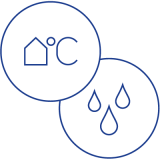The »inside« of the blanket
A printing blanket consists of several layers of different materials. The main constituents are rubber, fabric and air. These are distributed as follows: 45% rubber compound, 45% fabric and approx. 10% air-gas mixture.
General function
The printing blanket transfers the ink from the printing plate to the substrate. The ink must be taken quickly off the plate and applied just as quickly onto the surface of the substrate. The ink should be transferred completely, without streaks or other textures appearing in the image. This is important in order to achieve optimal dot definition and minimum dot gain. In addition, the blanket must release the print sheet or paper web quickly. Web tension, paper transport and register accuracy are essential factors that may be influenced by the printing blanket.
State of the art
The structure and technology of blankets available today are standardized to a great extent. Continuous improvement of the rubber compounds and fabric carriers ensures that blankets meet the requirements of new printing press generations.
Clamping Bars
Clamping Bars
The range of rail profiles for printing blankets is very diverse today. There is a choice of U-type bars and nip bars made of steel, aluminum bars, flat bars made of spring or stainless steel and aluminum adapter bars. You will find suitable bar profiles for most press types in the printing press index.
Fastening
We pay special attention to an optimal fastening of the clamping bars to the printing blanket, an essential factor for safe use of the blankets. We have been using eco-friendly, heat-reactive adhesive systems for many years. They allow us to avoid solvents and cleaning agents altogether. An automatic unit for heat-activation of the adhesive layer monitors compliance with process parameters inline and saves up to 60% energy compared to conventional hot presses.
Quality Check
We subject our barred printing blankets to various stress tests with special test equipment. In doing so, we also document our compliance with the requirements of printing press manufacturers regarding the tensile strength of clamping bars. We check all quality parameters such as overall thickness, strength, etc. before, during and after production.
Print Quality
With a perfectly configured printing press and the »right« blanket, printers can influence not just the quality of their product, but also their productivity. With regard to printing blankets and coating plates, we are pleased to support our customers with a wide range of measuring and testing methods.
Checking mechanical parameters
We check the thickness and plane parallelism and the compressibility/load values of printing blankets. We also test the pullout strength of the clamping bars and perform adhesion tests on self-adhesive printing blankets and coating plates. Microscopic pictures of blankets and plates help us analyze their cross-section or surface.
Checking chemical parameters
To determine the resistance of blankets and plates to chemicals, we perform swelling tests with printing inks, dampening solutions and washing fluids. These tests assist Streb and our customers in the selection of material combinations and optimization of the printing process.
Evalutating print sheets
Densitometric analyses and microscopic examinations of a print sheet allow us to objectively evaluate a blanket's performance in transferring the print image. We can also determine the degree of gloss of coated surfaces by means of a reflectometer.
Blanket Storage

Unpack and store stacked or hanging
Printing blankets should be unpacked after delivery and then stored either lying flat in a stack or hanging from a rack. When stacking the blankets, make sure that cover plate rests on cover plate and carrier side on carrier side. There should not be more than 15 blankets in the stack.

Protect from direct sunlight and ozone
The blanket must not be exposed to direct sunlight or fluorescent light sources! Printing blankets should also not be stored near ozone sources such as electric motors, copy machines etc. Proximity to such sources may cause the blanket surface to become porous and cracked.

Temperature and air humidity
The storage temperature should be between 19°C and 24°C. The air humidity should not exceed 65%. Extreme fluctuations of temperature and humidity must be avoided!

First in – first out
Printing blankets should always be stored according to the »first in – first out« principle. The storage time should not exceed 12 months; longer storage may cause changes in the rubber surface.
Disposal and »Reach«
Our staff is often asked about the right way to dispose of printing blankets or the chemicals contained in them. EU Regulation 1907/2006 (REACH) states that chemicals exceeding a certain residual concentration in the product must be registered.
The "REACH registration" of the European Union does not apply to printing blankets or coating plates!
Unused blankets
Unused printing blankets have no harmful effect on health, air or water. They can be disposed of as household waste in accordance with the specifications of the safety data sheet.
Used blankets
The situation is more difficult in the case of used and dirty printing blankets. Various guidelines apply: they determine up to which concentration of contaminants the blankets may still be disposed of as household waste, and when they must be considered hazardous waste. We recommend asking your local waste disposal authority or your private waste disposal company for advice.
Recycling
Rubber is currently not recyclable in the strict sense of the word; the vulcanization process is irreversible and the material cannot be melted like thermoplastic plastics. Used tires may be shredded into granulate that is then used in road construction, for instance. In most cases, however, rubber is burned and used as a source of energy. In the case of printing blankets, the integrated fabric is the main problem: it cannot be separated from the rest of the blanket, is not resistant to rotting and therefore contaminates the rubber granulate.
You have questions about our products
or are still looking for the right product?
Contact us, we are pleased to help you.

Customer service line
Advice & Order
Phone: +49 6103 6005-0
SEND AN E-MAIL